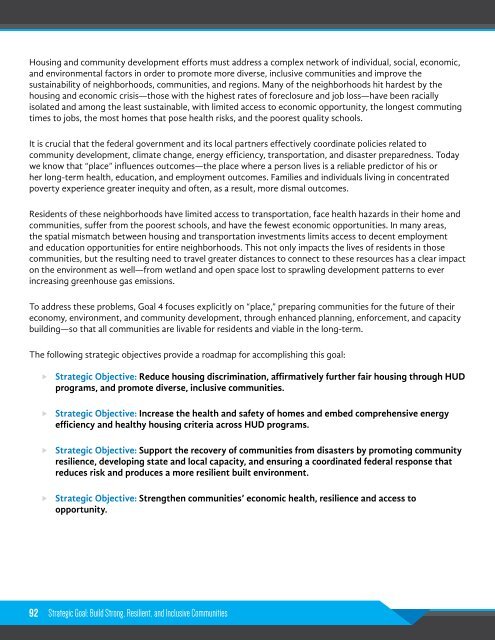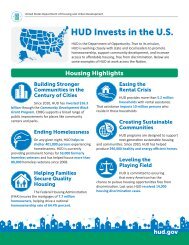Annual Performance Plan 508
Annual Performance Plan 508
Annual Performance Plan 508
You also want an ePaper? Increase the reach of your titles
YUMPU automatically turns print PDFs into web optimized ePapers that Google loves.
Housing and community development efforts must address a complex network of individual, social, economic,<br />
and environmental factors in order to promote more diverse, inclusive communities and improve the<br />
sustainability of neighborhoods, communities, and regions. Many of the neighborhoods hit hardest by the<br />
housing and economic crisis—those with the highest rates of foreclosure and job loss—have been racially<br />
isolated and among the least sustainable, with limited access to economic opportunity, the longest commuting<br />
times to jobs, the most homes that pose health risks, and the poorest quality schools.<br />
It is crucial that the federal government and its local partners effectively coordinate policies related to<br />
community development, climate change, energy efficiency, transportation, and disaster preparedness. Today<br />
we know that “place” influences outcomes—the place where a person lives is a reliable predictor of his or<br />
her long-term health, education, and employment outcomes. Families and individuals living in concentrated<br />
poverty experience greater inequity and often, as a result, more dismal outcomes.<br />
Residents of these neighborhoods have limited access to transportation, face health hazards in their home and<br />
communities, suffer from the poorest schools, and have the fewest economic opportunities. In many areas,<br />
the spatial mismatch between housing and transportation investments limits access to decent employment<br />
and education opportunities for entire neighborhoods. This not only impacts the lives of residents in those<br />
communities, but the resulting need to travel greater distances to connect to these resources has a clear impact<br />
on the environment as well—from wetland and open space lost to sprawling development patterns to ever<br />
increasing greenhouse gas emissions.<br />
To address these problems, Goal 4 focuses explicitly on “place,” preparing communities for the future of their<br />
economy, environment, and community development, through enhanced planning, enforcement, and capacity<br />
building—so that all communities are livable for residents and viable in the long-term.<br />
The following strategic objectives provide a roadmap for accomplishing this goal:<br />
Strategic Objective: Reduce housing discrimination, affirmatively further fair housing through HUD<br />
programs, and promote diverse, inclusive communities.<br />
Strategic Objective: Increase the health and safety of homes and embed comprehensive energy<br />
efficiency and healthy housing criteria across HUD programs.<br />
Strategic Objective: Support the recovery of communities from disasters by promoting community<br />
resilience, developing state and local capacity, and ensuring a coordinated federal response that<br />
reduces risk and produces a more resilient built environment.<br />
Strategic Objective: Strengthen communities’ economic health, resilience and access to<br />
opportunity.<br />
92 Strategic Goal: Build Strong, Resilient, and Inclusive Communities



